hankyoreh
Links to other country sites 다른 나라 사이트 링크
[Seoul travels] Mullae: a place to get lost and perhaps rediscover yourself

The rain may pour, the COVID-19 pandemic may rage, but life does go on. Even amid these somber events, people have been born and passed away; families have had to wrestle with upcoming wedding ceremonies. Life truly is a series of unknowable things.
“The aging process is linear, but isn’t it true to say that the essence of our lives is actually closer to nonlinear?” This is a thought that has often crossed my mind recently as I’ve spent more time recording and digitally editing videos for remote lectures. Unexpected things will sometimes intrude suddenly and turn everything upside down, but there are also times when the things farthest back move into the foreground. A nonlinear era certainly feels strange to us, but we will have to get used to it. Nonlinearity is a characteristic of the digital era -- the single biggest characteristic of the pandemic era -- and is rooted in complexity and unpredictability.
I decided to take a walk along the side streets of Seoul’s Mullae neighborhood. This is a place where work is being produced with the most analog methods, and where new things are being created through linear digital methods. Long-neglected regions on the periphery sometimes find themselves becoming the gold standard for fashion and transformation. Mullae is just such a place.
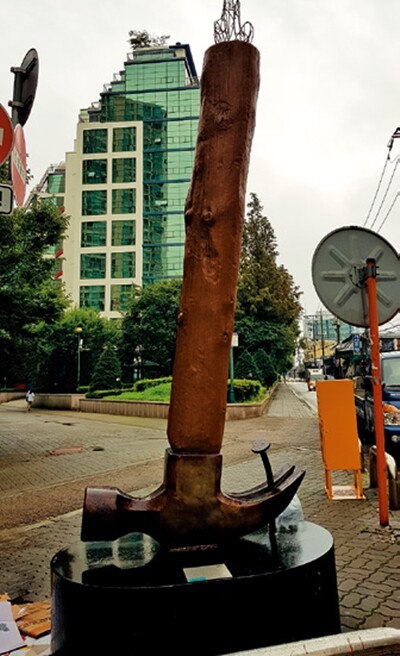
Stepping out of Exit 5 of the Seoul Subway’s Mullae Station, I was greeted right away by the Mullae Food Culture Alley. It was originally a shopping mall known as “Mullae-dong Rodeo Street,” but most of the stores closed down due to dwindling sales; after a large apartment complex was built nearby, it was transformed into a street dedicated to food. A few of the restaurants are constantly thronged with customers, including one called Wolhwa BBQ.
After taking a lap around the food alley, I began walking along Dangsan Road. As you take a few steps beyond Exit 7, you will see a metal sculpture by the side of the road where some shared bicycles have been parked. This is “Giraffe,” the neighborhood’s first work of public art. Before the crosswalk is a sign reading “Mullae Arts Village,” although it’s difficult to see if you aren’t looking for it. If you turn left while facing the sign for “Daewang Tripe” just before crossing the street, you will see two more creations. One is the “Welding Visor,” and behind that is a large sculpture of a hammer called “Nail-Pulling Hammer.”
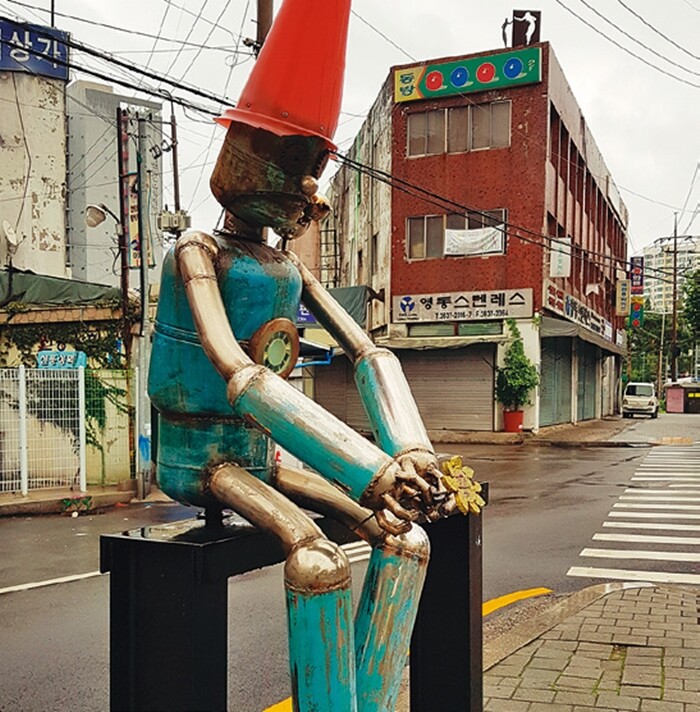
This small triangle of land where Dorim Road 128 and Dangsan Road 2 split off is the “golden triangle” that changed the face of Mullae. It signifies the convergence of the clattering ironworks, the arts village where young artists work, and the commercial area. The Mullae neighborhood was formed in the 1930s with the arrival of textile factories under the Japanese occupation; the name is said to have been adopted from the Korean word mulle (meaning “spinning wheel”) after liberation. As recently as the 1980s, it was a booming neighborhood filled with steel plants and metal vendors. But as the steel industry became increasingly mechanized and components began arriving from China, Mullae entered a period of decline.
The spaces left behind were eventually filled by artists, with high ceilings, affordable rent, and proximity to downtown Seoul making them appealing as studios. The arts scene received a further infusion of energy with the arrival of public institutions like the Seoul Foundation for Arts and Culture-built Seoul Art Space Mullae.
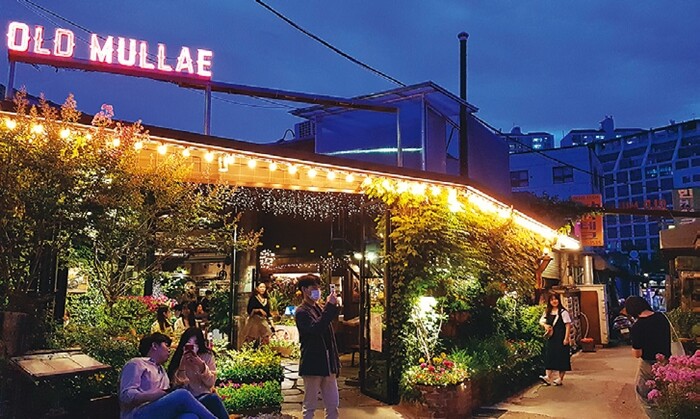
The side streets here bring together three main groups of people: longstanding ironworks veterans, young artists taking up residence in new studios, and tourists. As you tour the maze of side streets, you will spot an Industrial Bank of Korea branch at the very end of the Arts Village. In front of that side street is another sculpture -- this one a must-see. Considered a Mullae Arts Village mascot, this popular work of art shows a tin-plated robot with a red peaked “gokkal” hat on its head and a tin flower in its hand.
Early one morning, I headed over to the neighborhood to take pictures amid a respite from days of torrential rain. On the side streets, I saw a few middle-aged men gathered with paper cups in their hands. They are taking a break there with cups of 300-won (US$0.25) milk coffee and ginger tea from a vending machine. A store next to them had a sign advertising Americanos for 1,000 won (US$0.87) and bean sprout instant noodles for 2,500 won (US$2.18). These were not tourists, but real locals -- people weathering day after day of anxieties that the rising rent will one day force them out. They represent the dark side of gentrification.
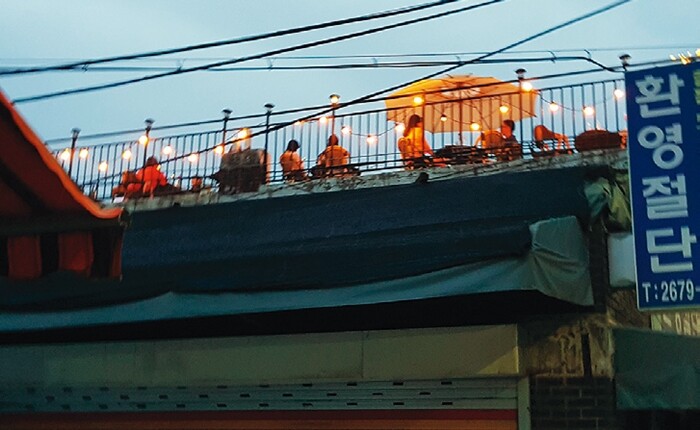
Night and day in Mullae are as different as, well, night and day. In the day, it is a neighborhood of ironworks and art; at night, it is identified with its visitors, cafes, and food culture. At the center of this are the narrow alleys, which extend from Mullae Park Junction and branch out from left to right around Dorim Road. Lots of different restaurants, coffee shops, and pubs lie hidden among these side streets. Yankees Burger and Pizza -- renowned among young people for its delicious pizza – and Old Mullae and Gallery Mullae, with their elegant interiors, are always packed. Seoul has been called a “cafe republic,” where new cafes and coffee shops seem to open and close overnight; this side street is no exception.
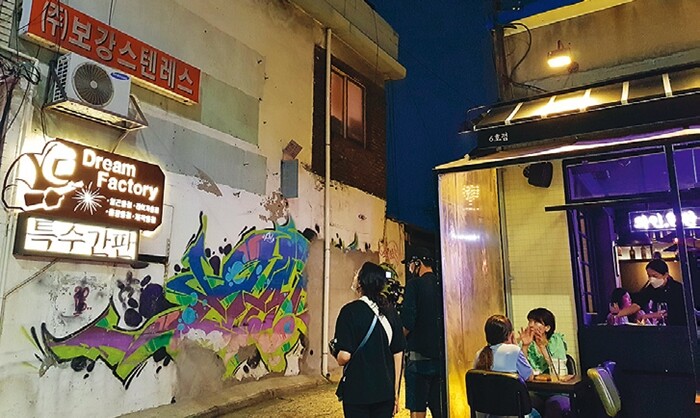
The signs themselves are another highlight of the Mullae side street tour. There’s a peculiar charm to walking alone while closely observing the distinctive vocabulary of the neighborhood -- words like “metal,” “plates,” “sectioning,” “shining,” “precision,” and “cutting.” A number of stores have retained the names of the old ironworks; some of the cafes were using the building roofs as outdoor settings. There’s a wide variety of sights to see, from the wall art that pops out around the odd corner to the people drinking “gamaek” (“store beer”) in front of side stores and the couples bringing photography equipment for YouTube videos. A neighborhood needs an infusion of youth to survive, and the alleys of Mullae at night are utterly packed with young people.
The side streets of Mullae are narrow and complicated. It’s easy to walk along only to find yourself back where you were before. The situation is similar to what they call “Ringwanderung” -- walking around in circles when you’re lost in the mountains or a desert. A lot of people have suffered from Ringwanderung nightmares during the pandemic. Disaster experts have stressed the importance of simply recognizing that you are walking in circles. Now that you’ve recovered your sense of direction, why not take a few slow steps toward the exit?
By Son Kwan-seung, travel writer
Edited by Seoul& editorial board
Please direct comments or questions to [english@hani.co.kr]
Editorial・opinion
![[Column] Has Korea, too, crossed the Rubicon on China? [Column] Has Korea, too, crossed the Rubicon on China?](https://flexible.img.hani.co.kr/flexible/normal/500/300/imgdb/original/2024/0419/9317135153409185.jpg) [Column] Has Korea, too, crossed the Rubicon on China?
[Column] Has Korea, too, crossed the Rubicon on China?![[Correspondent’s column] In Japan’s alliance with US, echoes of its past alliances with UK [Correspondent’s column] In Japan’s alliance with US, echoes of its past alliances with UK](https://flexible.img.hani.co.kr/flexible/normal/500/300/imgdb/original/2024/0419/2317135166563519.jpg) [Correspondent’s column] In Japan’s alliance with US, echoes of its past alliances with UK
[Correspondent’s column] In Japan’s alliance with US, echoes of its past alliances with UK- [Editorial] Does Yoon think the Korean public is wrong?
- [Editorial] As it bolsters its alliance with US, Japan must be accountable for past
- [Guest essay] Amending the Constitution is Yoon’s key to leaving office in public’s good graces
- [Editorial] 10 years on, lessons of Sewol tragedy must never be forgotten
- [Column] A death blow to Korea’s prosecutor politics
- [Correspondent’s column] The US and the end of Japanese pacifism
- [Guest essay] How Korea turned its trainee doctors into monsters
- [Guest essay] As someone who helped forge Seoul-Moscow ties, their status today troubles me
Most viewed articles
- 1[Column] The clock is ticking for Korea’s first lady
- 2Hong Se-hwa, voice for tolerance whose memoir of exile touched a chord, dies at 76
- 3After 2 months of delayed, denied medical care, Koreans worry worst may be yet to come
- 4[Column] Has Korea, too, crossed the Rubicon on China?
- 5US overtakes China as Korea’s top export market, prompting trade sanction jitters
- 6[Correspondent’s column] In Japan’s alliance with US, echoes of its past alliances with UK
- 7All eyes on Xiaomi after it pulls off EV that Apple couldn’t
- 8Samsung barricades office as unionized workers strike for better conditions
- 9[Photo] Smile ambassador, you’re on camera
- 10[Correspondent’s column] The US and the end of Japanese pacifism